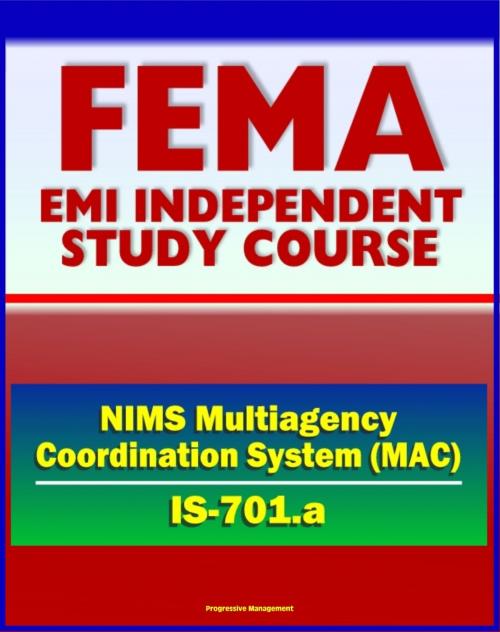21st Century FEMA Study Course: National Incident Management System (NIMS) Multiagency Coordination Systems (IS-701.a)
Nonfiction, Social & Cultural Studies, Political Science| Author: | Progressive Management | ISBN: | 9781466153202 |
| Publisher: | Progressive Management | Publication: | July 9, 2011 |
| Imprint: | Smashwords Edition | Language: | English |
| Author: | Progressive Management |
| ISBN: | 9781466153202 |
| Publisher: | Progressive Management |
| Publication: | July 9, 2011 |
| Imprint: | Smashwords Edition |
| Language: | English |
This Federal Emergency Management Agency (FEMA) independent training course manual from the Emergency Management Institute (EMI) introduces Multiagency Coordination (MAC) Systems as described in the National Incident Management System (NIMS), and shows how these systems can be used to improve incident response. MAC Systems consist of a combination of elements: personnel, procedures, protocols, business practices, and communications integrated into a common system. After taking this course, you should be able to improve the overall coordination with, and support for, incident management by developing and operating within MAC Systems.
Topics covered include scenarios, the Baltimore Howard Street Tunnel Railroad accident, NIMS, NRF, and an extensive glossary.
This course will describe to participants the components of a MAC System and establish relationships between all elements of the system. After taking the course, students should be able to:
* Define multiagency coordination at the local, tribal, State, and Federal levels of government.
* Define key terms related to Multiagency Coordination (MAC) Systems.
* Identify typical priorities established between elements of the MAC System.
* Describe the process of acquiring and allocating resources required by incident management personnel related to the entire MAC System.
* Identify potential coordination and policy issues arising from an incident relative to the entire MAC System.
The primary audience is Federal, State, tribal, and local emergency managers; first responders to include incident commanders from all emergency management disciplines; private industry personnel responsible for coordination activities during a disaster; and voluntary agency personnel.
This is a privately authored news service and educational publication of Progressive Management.
This Federal Emergency Management Agency (FEMA) independent training course manual from the Emergency Management Institute (EMI) introduces Multiagency Coordination (MAC) Systems as described in the National Incident Management System (NIMS), and shows how these systems can be used to improve incident response. MAC Systems consist of a combination of elements: personnel, procedures, protocols, business practices, and communications integrated into a common system. After taking this course, you should be able to improve the overall coordination with, and support for, incident management by developing and operating within MAC Systems.
Topics covered include scenarios, the Baltimore Howard Street Tunnel Railroad accident, NIMS, NRF, and an extensive glossary.
This course will describe to participants the components of a MAC System and establish relationships between all elements of the system. After taking the course, students should be able to:
* Define multiagency coordination at the local, tribal, State, and Federal levels of government.
* Define key terms related to Multiagency Coordination (MAC) Systems.
* Identify typical priorities established between elements of the MAC System.
* Describe the process of acquiring and allocating resources required by incident management personnel related to the entire MAC System.
* Identify potential coordination and policy issues arising from an incident relative to the entire MAC System.
The primary audience is Federal, State, tribal, and local emergency managers; first responders to include incident commanders from all emergency management disciplines; private industry personnel responsible for coordination activities during a disaster; and voluntary agency personnel.
This is a privately authored news service and educational publication of Progressive Management.















